Basic elements of FEM diagram: Process, Asset, Note
| Element | Definition | Explanation |
|---|---|---|
  | Process – repeatable sequence of activities. Double line identify a so called primary process – a process that produces value for “outside world”, e.g. client or customers. A primary process has a beneficiary (this concept is discussed later | The concept can be used on various levels of granularity, e.g. manufacturing process as a whole from order to delivery, including logistic, or just Assembling a product. |
  | Asset – something in procession of the organization that is needed and is used in one of its processes. A tacit asset is something that exists in the heads of a group of people. | An asset can be people, money, knowledge, equipment, etc. They can. play different roles in a process,e.g. a workforce, or infrastructure, see the next table on the roles of assets. |
 | Note – to place comments and explanation that cannot be inserted in the labels |
Basic relations in FEM diagram: Used In, Manages and relates-to
| Element | Definition | Explanation/Comments |
|---|---|---|
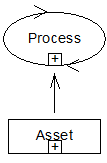 | Used In – a solid arrow from an asset to a process shows that the asset is used in some capacity in the process. | The label on the arrow explains in what capacity the asset is used in the process. There can be more than one label on an arrow. Labels are shown below in the table. |
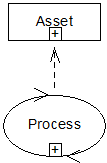 | Manages – a dashed arrow from an asset to a process shows that the process manages the asset in some way | The label on the arrow explains in what capacity the asset is used in the process. There can be more than one label on an arrow. Labels are shown below in the table. |
 | relates-to – a solid line from a note to some other elements shows that the note is related to this element The line does not have any special marks at the beginning and the end. | The relation has no label |
| Generic Used In relations | ||
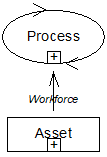 | Workforce – the asset consists of people trained and qualified for employment in the process, e.g., workers at the conveyor belt; physicians; researchers. They participate in activities related to the process. | This relation is used when the organization has full control over the people included in the asset, e.g. when they are employees. The activities in the process can also be completed by partners, see below. |
 | EXT (EXecution template) – the asset governs or controls the process in some way. This can, for example, be: a software development methodology accepted in a software vendor company; product design documentation for a manufacturer; technological process documentation, also for a product manufacturer; description of the service delivery procedure, e.g., a process map for a service company. | Note also that EXT does not need to be in a form of a procedure or algorithm. For example, a policy document on equal opportunities in recruitment of staff is regarded as an EXT for the recruitment process. |
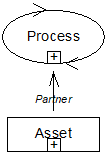 | Partner – the asset represent agents, external to the given organization, who participates in the process. This, for example, can be: a supplier of parts in a manufacturing process; a lab that completes medical tests on behalf of a hospital. | Partners can be other enterprises or individuals, e.g., retired workers that can be hired in case there is a lack of a skilled workforce for a particular process instance. Partners can be supplier, subcontractors or other organizations providing services to the given organization. |
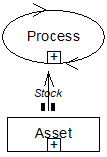 | Stock – the asset represents things that are consumed by the process. It can be a stock of materials or parts that are used in the process. It can be patients in the hospital or students of educational institution that are admitted or enrolled, go through the process of treatment or education, and disappear in the external world. This label is often appears with other labels, e.g. EXT or Partner. | When the stock label is used the arrow that represents the relation is marked with two short lines. This is done to highlight special property of the stock asset. The elements of the stock disappear in the process, and cannot be reused. If there is no stock label the asset is reused multiple times. It also means that the asset needs to be constantly filled with new elements. This label may represent an input for the process. |
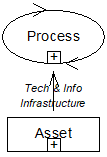 | Technical and Info(rmational) Infrastructure – the asset represents equipment used in the process. | It can be: a production line; computer; communication line; building; software system; database or other source of information. |
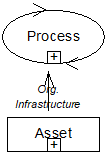 | Org.(anizational) Infrastructure – the asst represent a set of organizational units that are responsible for the process functioning. | This, for example, can be: sales department; software development team. One asset can represent several department and/or teams. Org.infrastructure is different from workforce, despite the workforce may belong to a unit of organizational infrastructure. |
| Specific Used In relations | ||
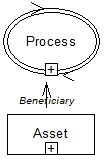 | Beneficiary – a set of people or organization attached to the given one that get value from the primary process (depicted by double line) | Beneficiary are getting value, while somebody pay for it. This can be beneficiary themselves directly, or somebody else who paid for them. It can sponsors, or governments. In the latter case, the beneficiary pays indirectly, through paying taxes to the government. |
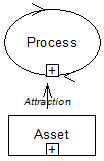 | Attraction – something that is used to recruit stakeholders, e.g. customers, workforce or partners. | Ir can be value proposition, reputation, or any other real or tacit asset that helps acquire stakeholder |
| Manages relations | ||
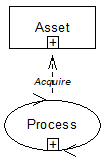 | Acquire – a process that adds elements to the asset | What it does depends on the asset. It can be hiring new members of staff, acquiring new customers, buying or development of new IR systems, etc. |
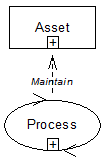 | Maintain – a process to maintain the elements of the asset in working order | It can be training members of staff, servicing equipment, fixing bugs in IT systems, managing relations with customers. |
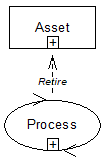 | Retire – a process to remove elements of assets that no longer can be used in the processes were | Examples, retiring members of staff, phasing out old equipment, cancelling the contract with partners, etc. |
Decomposition of assets and processes
| Element | Definition | Explanation/comments |
|---|---|---|
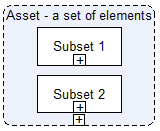 | Decomposition of an asset. Asset as a set of elements is presented as two subsets. Labels identify what is included in each. To make a decomposition in the FEM toolkit, the modeler needs to make the original asset into group, which will change the shape , the borders will get rounded corners and becomes delimited with a dashed line. After that, it is possible to place other assets inside the original one. | This decomposition realizes a “set” relation between two assets, e.g. a “Subset 1” is a subset of asset “Asset – a set of elements”. |
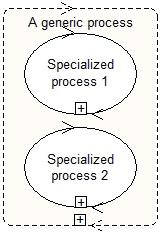 | Decomposition of a generic process in a set of specialized processes that realized the generic one. To make a decomposition in the FEM toolkit, the modeler needs to make the original process into group, which will change the shape to the rectangle with rounded corners and dashed borders. After that, it is possible to place other processes inside the original one. | This decomposition realizes a “specialization” relation between two processes, e.g. a “Specialized process 1” is a specialization of process “A generic process”. |
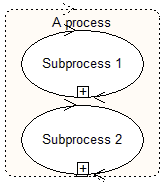 | Splitting of a generic process in a set of subprocesses. To make such a splitting in the FEM toolkit, the modeler needs to make the original process into group, and define this group as a subprocesses group. This will change the shape to the rectangle with rounded corners and dotted borders. After that, it is possible to place other processes inside the original one. | This decomposition realizes a “specialization” relation between two processes, e.g. a “Specialized process 1” is a specialization of process “A generic process”. |
